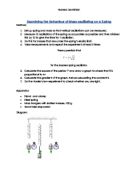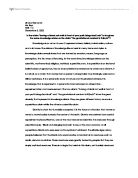The data that I will need to record are the rest position of the spring (same for each trial), stretched position of the spring, and the total mass hanging from the spring for each weight added. I will check the weights of the loads on electronic scales to ensure they are correct.
I will add the weights in 1 N loads, starting with 2N, and record the extension (Δx) in cm. I will do this until 10 N have been added. I will then repeat this twice for each of the three springs. I will repeat this using the loading unloading technique. This method is acceptable as I will not be exceeding the limit of proportionality and there will therefore be no permanent stretch.
*3*
Variables which alter
- Force applied to the spring
- Extension of the spring
Variables to control
- Construction of the spring
- Use the same person to take measurements each time
Justification
I will begin the experiment by adding 2N as this allows the spring to enter the limit of proportionality. I will add the loads 1 N at a time as this gives an easily measurable extension. I will stop at 10 N as beyond this point, the spring will exceed the limit of proportionality and reaches the elastic limit. (This causes the graph to become a curve.) Hooke’s law only applies to a spring that is within its limit of proportionality. I have decided to set up the apparatus in this way, because although I could have set up the apparatus in a way that error due to gravity was not a factor, the equipment I had was not all compatible. This would produce results that were not accurate enough to exceed those of the experiment above because of this problem.
This would have been the alternative experiment:
Error identification
Random
My ruler only measures to the nearest 0.001m so my results could be up to 0.0005cm too small or large.
Systematic
Attaching the spring to the clamp and the weight will reduce the measurable length
If the ruler is not perfectly vertical, all of the measurements will be too small
The spring itself has a weight.
*4*
Action on errors
Random
I will repeat each reading twice and take a mean average of these to reduce random error.
Systematic
I will attempt to attach the spring as close to the edge as possible.
I will correctly attach the rule when setting up the equipment. To ensure this I will use a plumb line to find the perfect vertical line.
I cannot correct the problem of the spring itself having a weight as an experiment in which this is not a problem cannot be set up to an appropriate degree of accuracy.
Results:
*5*
Calculations and errors:
Spring 1
K=F _ = (8-2) = 29.197 _ (max)
X (0.239-0.0355)
Spring 2
K= F _ =(8-2) =28.708 (min)
X (0.241-0.032)
Spring 3
K=F _ =(8-2) =28.986
X (0.240-0.033)
Average
Mean average spring constant = 29.197 + 28.708 + 28.986 = 28.964
3
Error
Spring 1 has the maximum spring constant, spring 2 has the minimum spring constant.
Error = max – min
2
Therefore: = 29.197 - 28.708
2
=0.2445
The final answer therefore is 28.964 ±0.2445 N/m
Analysis and interpretation of results
The result does support the original prediction. From the preliminary, it was known that the spring constant was to be around 27.78N/m, and in the main experiment it was found to be 28.964±0.2445N/m. The results did show that extension was linearly proportional to force applied which supports the theory of Hooke’s law. Hooke’s law states that within a springs limit of proportionality, a spring will extend in proportion to the force acting upon it. He derived the equation F=Kx where F= force in Newtons, K= spring constant and x= extension in metres. For my experiment, I manipulated this equation to give K= f/x and K could then be calculated. My results completely support this and using my graph, I have concluded the error is ±0.2445, which is only ±0.84%. I believe this to be very accurate.
*7*
Evaluating evidence
Systematic errors
The main source of systematic error in this experiment was the weight of the spring itself. If the spring was originally clenched, this would not affect the extension. If, however, the spring was originally slack, then its own weight will stretch it, making values of extension too large due to gravitational forces.
Random errors
The two most significant random errors were the values of extension (±0.0005m) and the loads used (±0.0055N). To reduce random error I have repeated the experiment for each spring.
Uncertainty of weights
Uncertainty of weight readings = (max – min) /2 = (-0.008 + 0.003) /2 = ±0.0055
The uncertainty of the weights (F) was the largest and was therefore the most significant.
In this experiment the only anomalous result was in spring 1 and this was shown, as the spring did not return to its original length. (Elastic by definition is a material which returns to its original length / shape after extension.) This can be explained as I measured the spring with a paperclip attached to the bottom coil of the spring. This coil may have unfurled slightly making the overall measured length of the spring longer. The spring constant for the preliminary, and for the main experiment, were different but this was because no average was taken for the preliminary and it exceeded the limit of proportionality. Also, the spring, although supposedly the same, was from a different batch.
The values which were the smallest, and therefore the most significant, were the measure of extension of the spring. This was measured with a metre rule with 0.001m increments. This meant my answer could be given to 3 decimal places. However, as my results are conclusive to Hooke’s law, I believe them to be precise. I also checked my results with another member of my group. Her results were 28.169N/m ±0.423. Her results were gathered using similar techniques to mine and with a spring from the same batch.
*8*
Improvements and further work
If this experiment was to be done again I would have used the experiment originally devised, but I would have to make something more appropriate to hold the spring so the parts would all work together. This feature was the main part that stopped me from using this method. It would have reduced the error due to gravity. The only problem would have been the possible stretching of the wire, but this is very unlikely, as it is the strongest link in a weak chain.
I could also do the experiment with a larger range (exceeding the elastic limit) and do more repeats.
Laura Yeomans 12s
*9*







